Upside-down gardening: September in Central Otago

Spring is officially here
The first day of spring is officially 1 September, The spring equinox is on 23 September and that is when seeds seem to germinate faster and seedlings establish themselves in the garden more readily. In the meantime, the procession of spring flowers continues.
Dreamy bluebells
As the snowdrop flowers turn into yellow seedpods, bluebells take their place. They remind me of English woods, but I don’t think the ones in our garden are true English bluebells. Bluebells hybridise readily, especially with Spanish squill, but also with other members of the hyacinth family. I once read that English bluebells should have heads that arch elegantly “like sad knights”. Ours are a lighter blue than the true English bluebells and they stand vigorously erect. I split them and spread them around regularly, because I would love the area under the trees to be a carpet of blue each September.
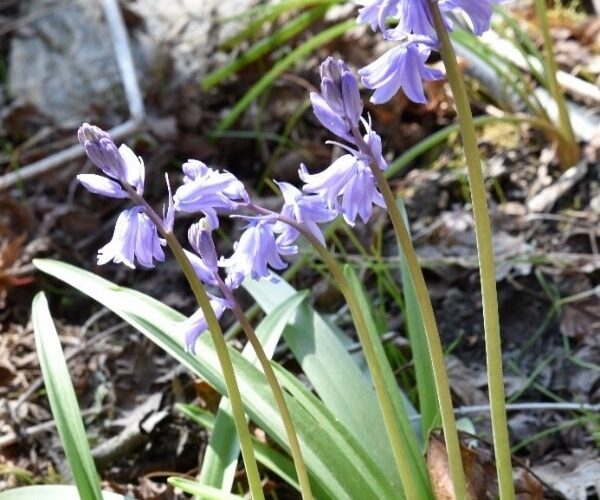
Delicate fritillaries
This solitary beauty emerges each year amongst the grape hyacinths. Fritillaries are another reminder of England, where they like to grow in damp meadows on the edge of woodland. This is the white version of the snakes head fritillary (fritillaria meleagris), but the purple one is also interesting-looking with a chequerboard effect on its petals. Now that I know they will thrive in this area of the garden, I ought to get some more.
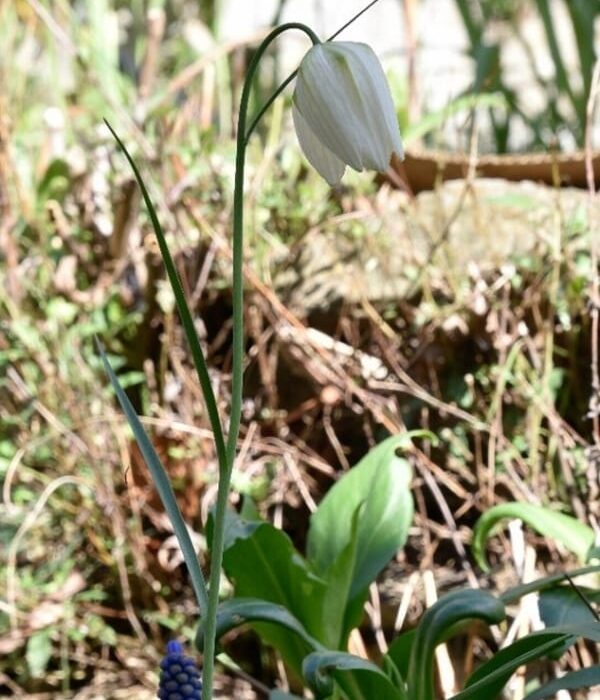
Tiny hooped petticoat daffodils
There are lots of these in the garden, but they haven’t flowered particularly well this year. I suspect they have become a little overcrowded, so I will split them up and spread them around. The ordinary daffodils were also a little disappointing. However, proving that they love poor, dry soil, a few that I put into a bed that does not receive any irrigation and where the soil has been depleted of nourishment by a row of “dwarf” conifers flowered beautifully, unlike the clumps in better soil elsewhere. The flowers look like the sort of petticoats worn underneath crinoline dresses.
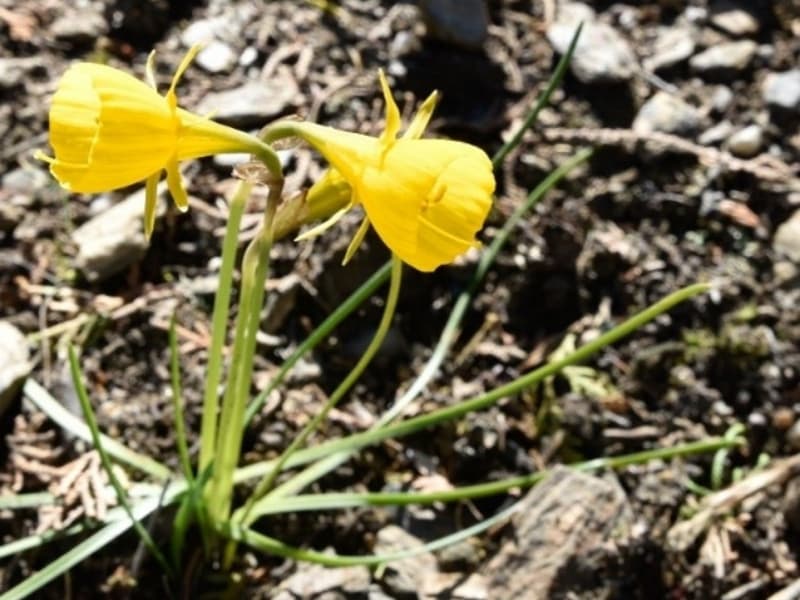
Fabulous tulips
Tulips are rapidly becoming my favourite spring flower. In some locations, tulips have to be lifted and replaced every year. This is not true here. Central Otago’s cold winters, strong sunshine and sharp drainage seem to be just what they need to thrive without any special care.
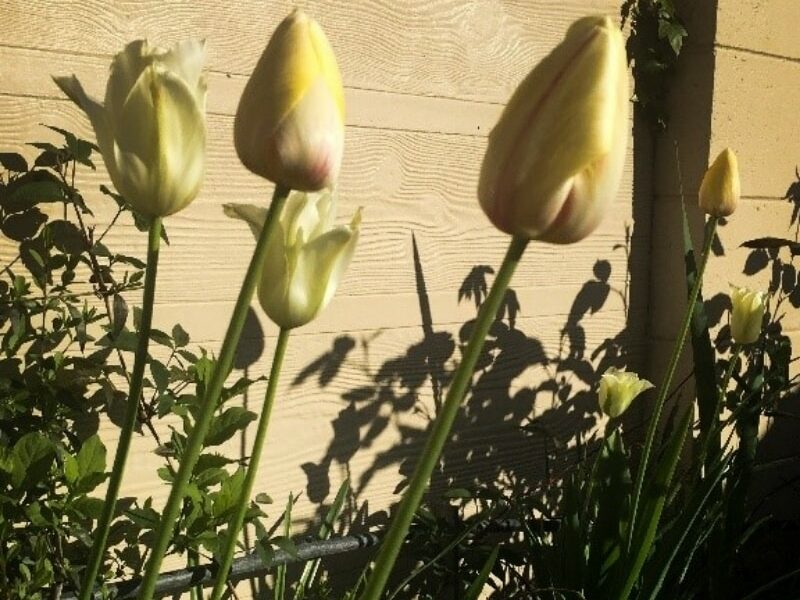
Dreamy pastels
Proving that tulips don’t need much effort here, tulips Camargue and Spring Green are in their third year of flowering. They give me just the kind of dreamy look that I want in this bed, which is where I put mainly pastel-coloured flowers. As the original bulbs have divided and spread, the formal planting I originally made has become much more natural-looking.
Rich doubles
These lovely doubles are in their second year of flowering in a dry, exposed bed. If I remember rightly, they are Menton Unique.
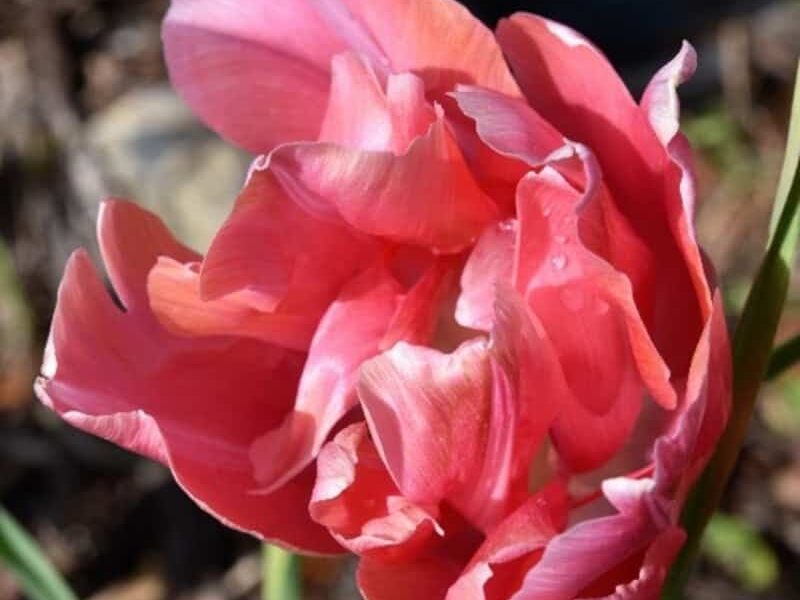
Magnificent magnolias
Magnolia soulangeana
Before we lived here, this large magnolia near the boundary fence grew back from a stump when the original tree, which was right on the boundary, was cut down. It has grown rather tall and unshapely, so I’m going to persuade my husband to cut the top back. It does not have a strong leader, so we are hoping that we can encourage it to become bushier, rather than growing straight up.
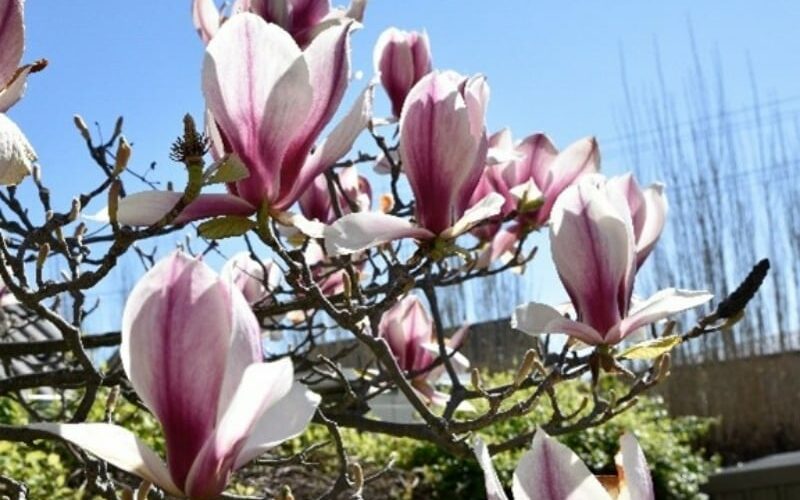
Magnolia Genie
We chose this magnolia because its colour would contrast well with the magnolia it was to be planted near to and because it is bred not to grow too large, making it an ideal small tree for a modestly sized town garden. We planted it three years ago, and almost lost it when, in spite of being watered early in the morning, the afternoon sun dried it out completely. This year, it seems strong and healthy, and we have learned to be extra diligent about irrigating young plants.
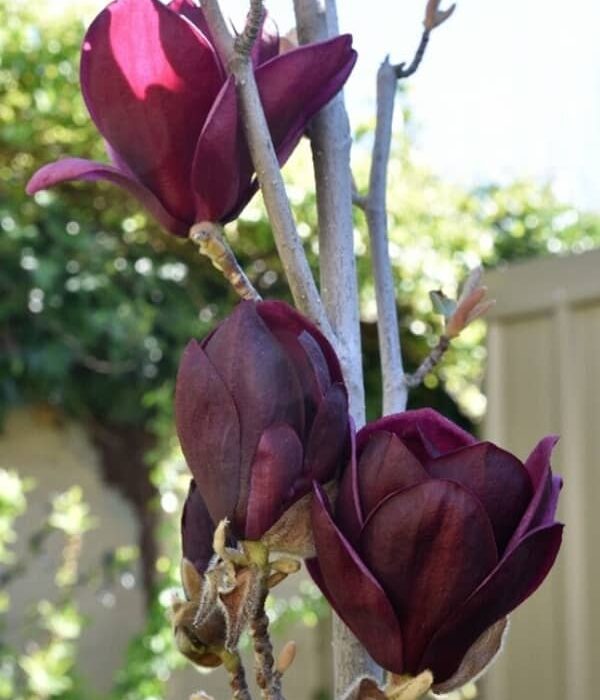
Fascinating trilliums
Trilliums got their name because of their structure, all based on threes. This dark-coloured one has been in the garden since before I moved in. You can also get yellow, white, and pink speckled ones, and many varieties have beautifully marbled leaves. Trilliums come from America, where they are woodland wildflowers. They are best grown in shade, where they make leaves and flowers early in the season, before the tree canopy develops.
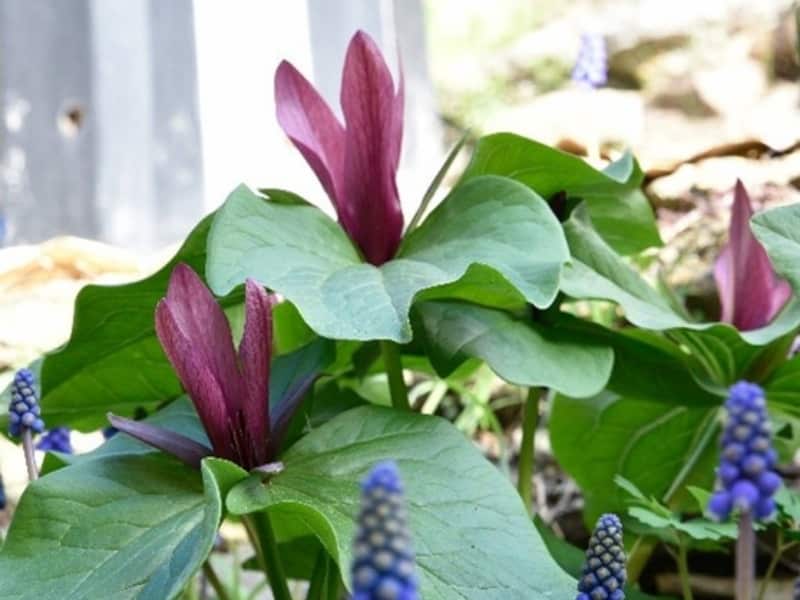
The vegetable garden
Free food
I have always loved asparagus. In the UK, it is quite expensive and has a short season, and UK gardeners who want to grow it are given complicated instructions involving digging trenches and incorporating lots of organic matter. Here, asparagus grows wild out of the rocks. I find it everywhere in our garden, where it has self-seeded and needs no attention at all. I’m happy for it to grow amongst the flowers, but I do try to keep it at the back of the border, where its feathery fronds make a nice background for the flowers. I’m currently picking a few spears every day, which I throw in with a stir-fry or microwave between two plates for thirty seconds and then gobble up with lots of good New Zealand butter. It contains vitamin K, minerals and trace elements, just what you need after winter.
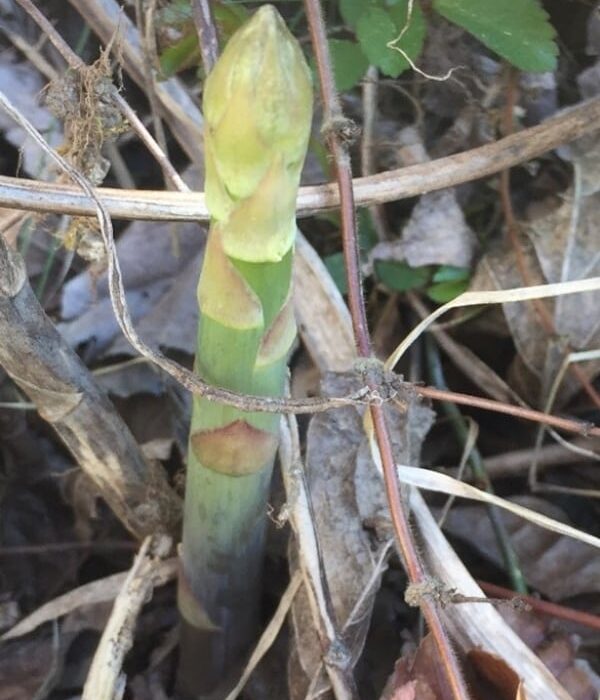
Planting out seedlings
I’m raising and planting out seedlings as fast as I can. I don’t have a greenhouse, so all my seed-raising is done on a windowsill. I am aiming to grow just a few plants, but with a wide variety. When I plant out a seedling, the blackbirds and thrushes (including the very tame blackbird who comes back every year) pull out the little plant and fling it to one side in their search for worms and grass grubs. I have been piling up rocks around them or placing a metal grill over them to try to prevent this, but I think we need to look at a more elegant solution for the vegetable bed, perhaps a set of hinged cages. I planted several carrot seedlings at the end of September and have a number of dwarf and climbing beans germinating on the windowsill.
Jobs to do in the garden in September
Split up clumps of bulbs
If you have clumps of bulbs that are becoming congested, split them up and spread them around once they have finished flowering.
Sow seeds indoors
In comparison to previous months, a much larger range of seeds can be sown, and this will make you quite busy. Your priority will be raising seeds and planting out seedlings as soon as they are ready, to make space on your windowsill for sowings of beetroot (great for salad leaves as well as for the sweet roots), cabbage, carrot, lettuce, New Zealand spinach, parsnips, radishes, rocket, swedes, shallots and spring onions. Sow chilli and aubergine seeds now, too. When they have two true leaves, pot them on and keep them indoors until there is no more likelihood of frost. I like to keep the pots all together in a large plastic tray, so that I can water and feed them from below. I have them in front of a patio door (known as ranch sliders here).
Sow seeds outdoors
Peas of every kind, including mangetouts and snow peas can be sown directly where you want the plants to grow. It’s good to have a succession of peas, so sow a few each week. You can also sow broad beans if you didn’t sow them in winter.
Protect seedlings from the birds
Blackbirds and thrushes are intelligent and inquisitive. They like to investigate any new plantings in the garden, and you may find that they will pull up your carefully raised seedlings and fling them on the ground. Use metal grids, stones or horticultural fleece to protect your seedlings until they are firm in the ground.
About the writer
My name’s Pamela and a few years ago, at the age of 55, I made the decision to start a new adventure. I left the northwest of England, where I had lived all my life, and moved to New Zealand. I’m excited to be a guest blogger on Gardenize, and I love writing about my garden in beautiful, sunny Alexandra in Central Otago. My garden here is about as different as it could get from the damp, shady garden I left behind. Central Otago is the hottest, driest, coldest area in New Zealand, as we have hot summers and cold winters, along with a semi-arid climate. The area is famous for its orchards and vineyards. It has many quaint little rural townships with pretty cottage gardens featuring peonies, bearded irises, hollyhocks, lilies, roses, and lavender that grow so well here. The landscape is spectacular, with dry, rocky mountains and impossibly blue lakes and rivers. The dry mountains look barren, but they’ve actually covered in tough little thyme plants: a great clue to what might grow well in the garden.

GARDENIZE GARDEN APP
Your garden friend with green fingers and photographic memory.
Gardenize is an app for gardening and cultivation that helps you to overview, understand and develop your garden and your crops. Organizing your garden makes it easier to succeed and your Gardenize app structures all information and make it searchable. You’ll get tips and inspiration from other Gardenizers around the world. All Gardenize basic features are free to use. You can download the app from the App Store or Google Play, or create an account directly in the web app in your browser. Get to know Gardenize better here.
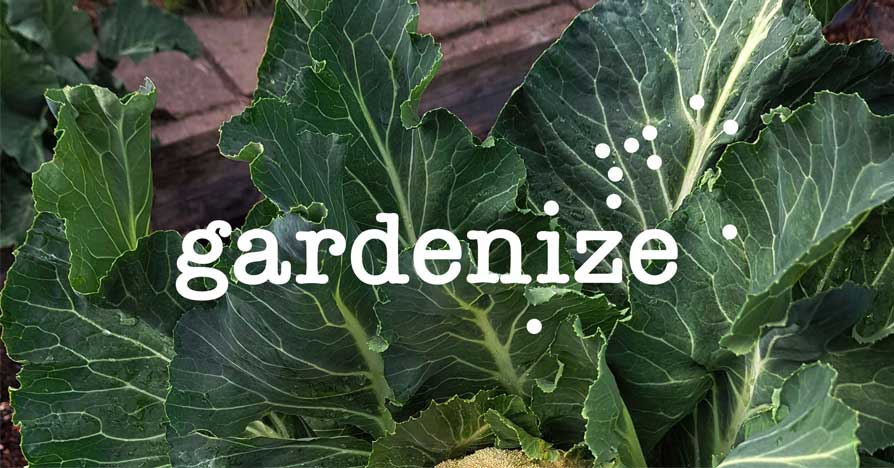
More to read from Gardenize
Images published on the Gardenize website belong to Gardenize AB and may not be used without permission.


